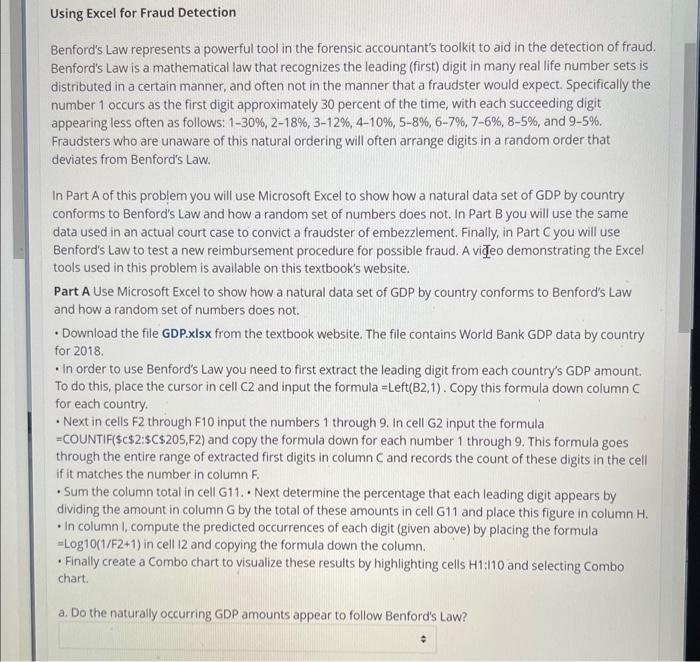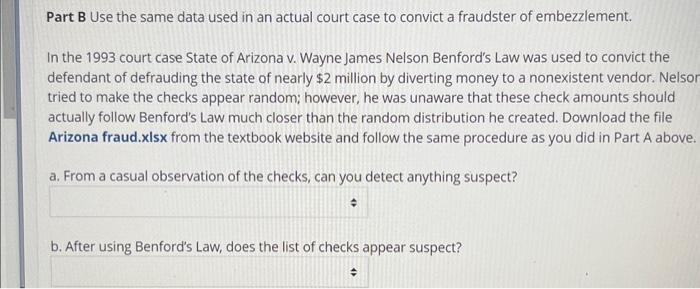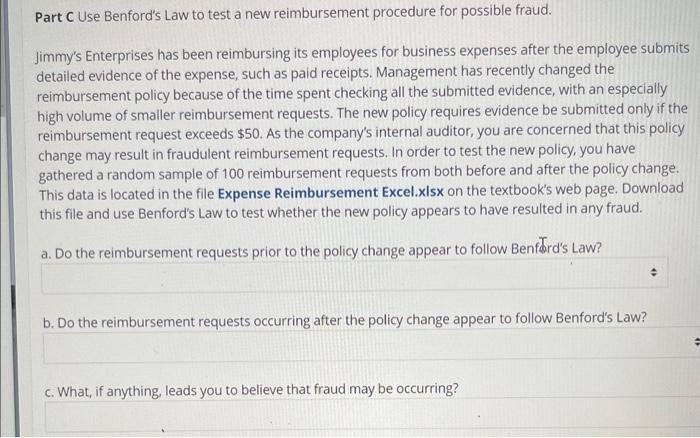yes or no, for each question!

Using Excel for Fraud Detection Benford's Law represents a powerful tool in the forensic accountant's toolkit to aid in the detection of fraud. Benford's Law is a mathematical law that recognizes the leading (first) digit in many real life number sets is distributed in a certain manner, and often not in the manner that a fraudster would expect. Specifically the number 1 occurs as the first digit approximately 30 percent of the time, with each succeeding digit appearing less often as follows: 130%,218%,312%,410%,58%,67%,76%,85%, and 95%. Fraudsters who are unaware of this natural ordering will often arrange digits in a random order that deviates from Benford's Law. In Part A of this problem you will use Microsoft Excel to show how a natural data set of GDP by country conforms to Benford's Law and how a random set of numbers does not. In Part B you will use the same data used in an actual court case to convict a fraudster of embezzlement. Finally, in Part C you will use Benford's Law to test a new reimbursement procedure for possible fraud. A video demonstrating the Excel tools used in this problem is available on this textbook's website. Part A Use Microsoft Excel to show how a natural data set of GDP by country conforms to Benford's Law and how a random set of numbers does not. - Download the file GDP.xlsx from the textbook website. The file contains World Bank GDP data by country for 2018. - In order to use Benford's Law you need to first extract the leading digit from each country's GDP amount. To do this, place the cursor in cell C2 and input the formula = Left( (2,1). Copy this formula down column C for each country. - Next in cells F2 through F10 input the numbers 1 through 9. In cell G2 input the formula = COUNTIF( $cS22sC$205,F2) and copy the formula down for each number 1 through 9. This formula goes through the entire range of extracted first digits in column C and records the count of these digits in the cell if it matches the number in column F. - Sum the column total in cell G11. Next determine the percentage that each leading digit appears by dividing the amount in column G by the total of these amounts in cell G11 and place this figure in column H. - In column I, compute the predicted occurrences of each digit (given above) by placing the formula =log10(1/F2+1) in cell 12 and copying the formula down the column. - Finally create a Combo chart to visualize these results by highlighting cells H1:110 and selecting Combo chart. a. Do the naturally occurring GDP amounts abpear to follow Renford's I aw? Part B Use the same data used in an actual court case to convict a fraudster of embezzlement. In the 1993 court case State of Arizona v. Wayne James Nelson Benford's Law was used to convict the defendant of defrauding the state of nearly $2 million by diverting money to a nonexistent vendor. Nelso tried to make the checks appear random; however, he was unaware that these check amounts should actually follow Benford's Law much closer than the random distribution he created. Download the file Arizona fraud.xIsx from the textbook website and follow the same procedure as you did in Part A above. a. From a casual observation of the checks, can vou detect anything suspect? b. After using Benford's Law, does the list of checks appear suspect? Part C Use Benford's Law to test a new reimbursement procedure for possible fraud. Jimmy's Enterprises has been reimbursing its employees for business expenses after the employee submits detailed evidence of the expense, such as paid receipts. Management has recently changed the reimbursement policy because of the time spent checking all the submitted evidence, with an especially high volume of smaller reimbursement requests. The new policy requires evidence be submitted only if the reimbursement request exceeds $50. As the company's internal auditor, you are concerned that this policy change may result in fraudulent reimbursement requests. In order to test the new policy, you have gathered a random sample of 100 reimbursement requests from both before and after the policy change. This data is located in the file Expense Reimbursement Excel.xlsx on the textbook's web page. Download this file and use Benford's Law to test whether the new policy appears to have resulted in any fraud. a Dn the reimhursement reauests orior to the nolicv change appear to follow Benfrd's Law? b. Do the reimbursement requests occurring after the policy change appear to follow Benford's Law? c. What, if anything, leads you to believe that fraud may be occurring? Using Excel for Fraud Detection Benford's Law represents a powerful tool in the forensic accountant's toolkit to aid in the detection of fraud. Benford's Law is a mathematical law that recognizes the leading (first) digit in many real life number sets is distributed in a certain manner, and often not in the manner that a fraudster would expect. Specifically the number 1 occurs as the first digit approximately 30 percent of the time, with each succeeding digit appearing less often as follows: 130%,218%,312%,410%,58%,67%,76%,85%, and 95%. Fraudsters who are unaware of this natural ordering will often arrange digits in a random order that deviates from Benford's Law. In Part A of this problem you will use Microsoft Excel to show how a natural data set of GDP by country conforms to Benford's Law and how a random set of numbers does not. In Part B you will use the same data used in an actual court case to convict a fraudster of embezzlement. Finally, in Part C you will use Benford's Law to test a new reimbursement procedure for possible fraud. A video demonstrating the Excel tools used in this problem is available on this textbook's website. Part A Use Microsoft Excel to show how a natural data set of GDP by country conforms to Benford's Law and how a random set of numbers does not. - Download the file GDP.xlsx from the textbook website. The file contains World Bank GDP data by country for 2018. - In order to use Benford's Law you need to first extract the leading digit from each country's GDP amount. To do this, place the cursor in cell C2 and input the formula = Left( (2,1). Copy this formula down column C for each country. - Next in cells F2 through F10 input the numbers 1 through 9. In cell G2 input the formula = COUNTIF( $cS22sC$205,F2) and copy the formula down for each number 1 through 9. This formula goes through the entire range of extracted first digits in column C and records the count of these digits in the cell if it matches the number in column F. - Sum the column total in cell G11. Next determine the percentage that each leading digit appears by dividing the amount in column G by the total of these amounts in cell G11 and place this figure in column H. - In column I, compute the predicted occurrences of each digit (given above) by placing the formula =log10(1/F2+1) in cell 12 and copying the formula down the column. - Finally create a Combo chart to visualize these results by highlighting cells H1:110 and selecting Combo chart. a. Do the naturally occurring GDP amounts abpear to follow Renford's I aw? Part B Use the same data used in an actual court case to convict a fraudster of embezzlement. In the 1993 court case State of Arizona v. Wayne James Nelson Benford's Law was used to convict the defendant of defrauding the state of nearly $2 million by diverting money to a nonexistent vendor. Nelso tried to make the checks appear random; however, he was unaware that these check amounts should actually follow Benford's Law much closer than the random distribution he created. Download the file Arizona fraud.xIsx from the textbook website and follow the same procedure as you did in Part A above. a. From a casual observation of the checks, can vou detect anything suspect? b. After using Benford's Law, does the list of checks appear suspect? Part C Use Benford's Law to test a new reimbursement procedure for possible fraud. Jimmy's Enterprises has been reimbursing its employees for business expenses after the employee submits detailed evidence of the expense, such as paid receipts. Management has recently changed the reimbursement policy because of the time spent checking all the submitted evidence, with an especially high volume of smaller reimbursement requests. The new policy requires evidence be submitted only if the reimbursement request exceeds $50. As the company's internal auditor, you are concerned that this policy change may result in fraudulent reimbursement requests. In order to test the new policy, you have gathered a random sample of 100 reimbursement requests from both before and after the policy change. This data is located in the file Expense Reimbursement Excel.xlsx on the textbook's web page. Download this file and use Benford's Law to test whether the new policy appears to have resulted in any fraud. a Dn the reimhursement reauests orior to the nolicv change appear to follow Benfrd's Law? b. Do the reimbursement requests occurring after the policy change appear to follow Benford's Law? c. What, if anything, leads you to believe that fraud may be occurring










